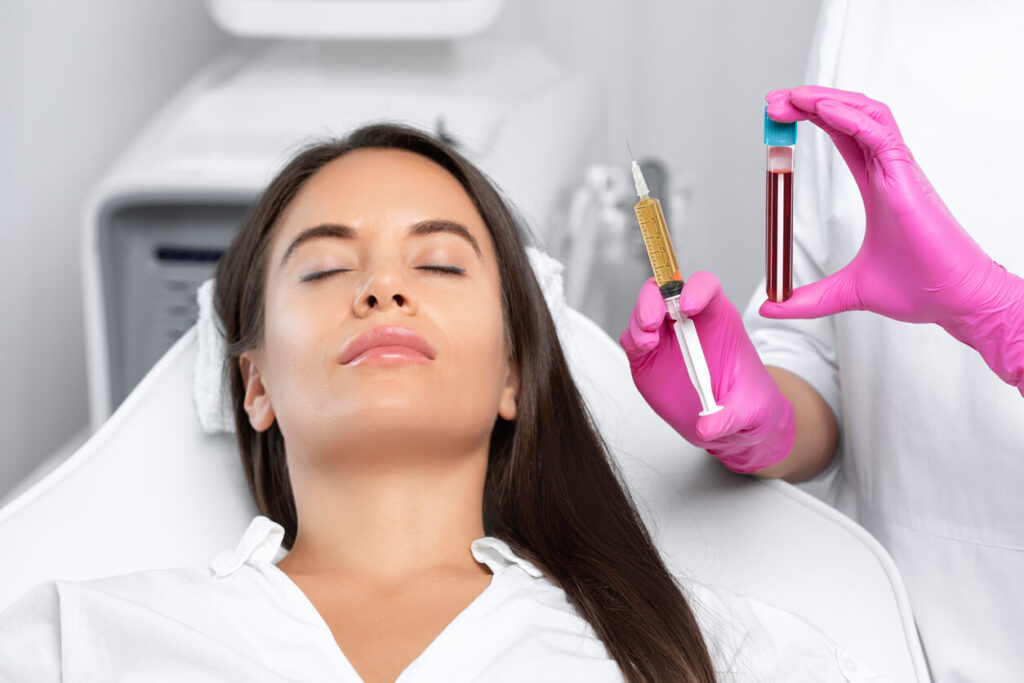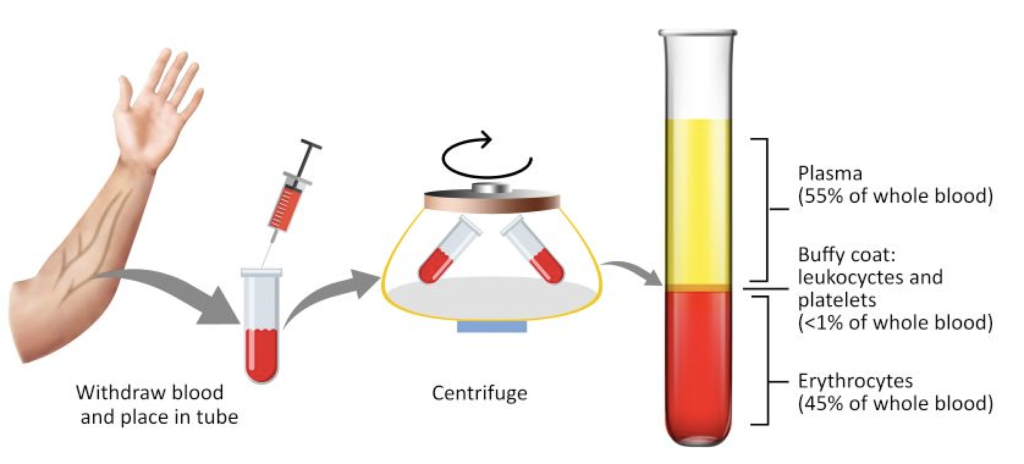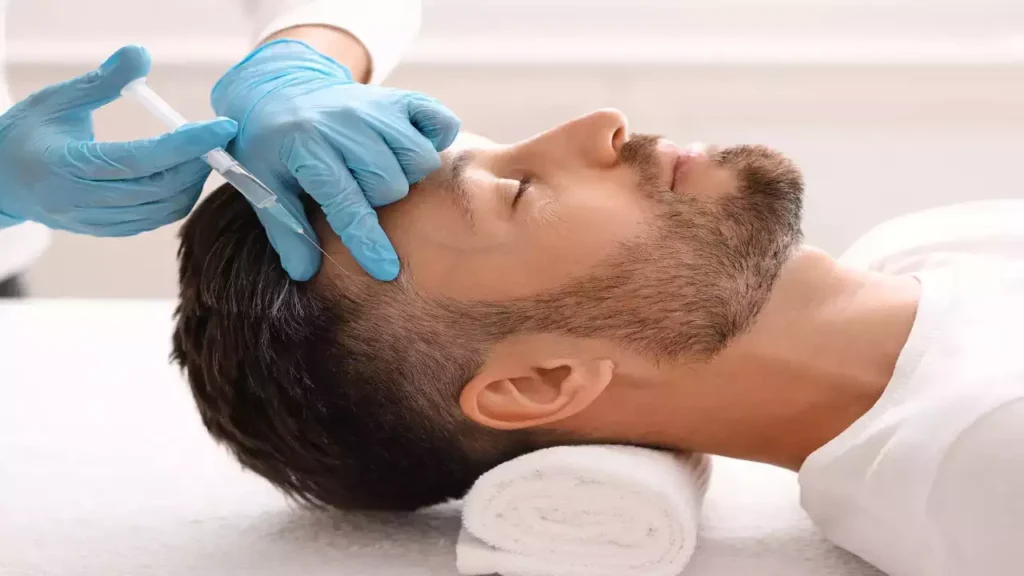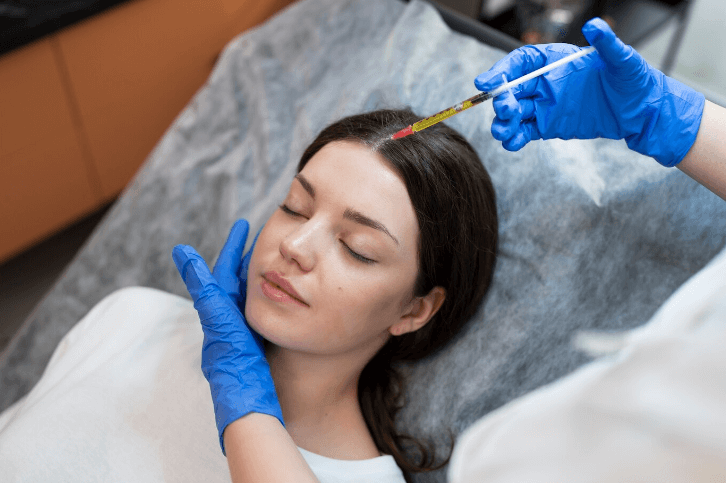Hair loss is a typical problem affecting millions regardless of age or gender. Regardless of the treatments, most patients often seek a non-invasive and effective solution.
Introducing PRP (Platelet-Rich Plasma) therapy—a non-invasive treatment that harnesses the regenerative powers of one’s own blood to stimulate hair growth and increase hair volume. This natural and effective approach has garnered a significant following due to its promising outcomes.
Our aim with this guide is to equip you with comprehensive knowledge about PRP therapy for hair restoration. We will delve into what PRP therapy is, its process, benefits, the procedures involved, and the ideal candidate. By the end, you will be well-prepared with information on PRP therapy and its potential as a solution for hair loss.
Now, PRP therapy is suitable for people who want to solve their hair loss problem using natural methods and without surgery. Come with us to discover how PRP therapy can improve your hair and quality of life.
For individuals seeking a convenient, non-invasive solution that improves scalp health and stimulates hair follicle activity, laser hair therapy (LHT) is a great choice. Combining the two could produce the best outcomes.
What is PRP (Platelet-Rich Plasma)Therapy?
- Definition of PRP Therapy: Platelet-rich plasma, or PRP, therapy is a medical intervention that stimulates hair growth and promotes healing by utilizing concentrated platelets from the patient. This treatment uses the body’s healing mechanisms to treat several ailments, including hair loss.
- Explanation of Platelet-Rich Plasma: PRP, or platelet-rich plasma, is made from a tiny amount of the patient’s blood. Platelets, necessary for tissue regeneration and repair, are extracted from the blood and concentrated. Rich in proteins and growth factors, the resulting platelet-rich plasma (PRP) promotes cellular renewal and repair.
- Components of Blood: Blood is made up of various essential ingredients:
Red blood cells, also known as erythrocytes, are responsible for returning carbon dioxide from the lungs for expiration and transporting oxygen to the rest of the body.
Leukocytes, or white blood cells, are immune system components that support the body’s defence against illnesses and external invaders.
- Plasma: The liquid portion of blood that serves as a medium for transporting cells, nutrients, hormones, and waste products throughout the body.
Platelets (Thrombocytes) are small, disc-shaped cell fragments essential for blood clotting that play a significant role in the body’s healing processes.
Role of Platelets in Healing and Growth

Platelets are responsible for blood coagulation and the release of growth aspects that promote tissue rejuvenation and repair. They gather at the site of tissue damage and release bioactive proteins that start the healing process. These growth factors improve tissue repair by promoting cell division and the creation of new blood vessels.
In the context of PRP therapy for hair restoration, these growth factors can:
By concentrating platelets and injecting them into areas of hair thinning or loss, PRP therapy harnesses the body’s innate healing capabilities to rejuvenate the scalp and encourage the growth of stronger, healthier hair.
Types of PRP Hair Restoration Procedures
PRP (Platelet-Rich Plasma) therapy for hair restoration can be categorized based on the preparation methods and the constituents of the PRP used. Here’s a differentiation between various PRP protocols and procedures, along with their advantages and limitations:
Single Spin vs. Double Spin Methods:
Pure PRP vs. Leukocyte-Rich PRP:
How PRP Therapy Works

Process of Obtaining PRP
A tiny amount of the patient’s blood is drawn initially for PRP therapy, usually from an arm vein. This procedure is usually quick and painless, like a standard blood test.
The drawn blood is put into a centrifuge, a specialized device that rapidly spins the blood. Based on density, this spinning process divides the blood into different components. The blood divides into three different layers during centrifugation:
– Red blood cells at the bottom.
– Platelet-poor plasma (PPP) at the top.
– The middle layer’s platelet-rich plasma (PRP) is highly concentrated in platelets and growth factors.
Using a syringe, the PRP-containing intermediate layer is carefully removed. Next, this PRP is ready to be injected into the scalp. PRP contains a notably higher concentration of platelets than normal blood, which means it is rich in proteins and growth factors critical for tissue regeneration and healing.
After the platelet-rich plasma (PRP) is ready, it is injected into the scalp regions that are balding or losing hair. Multiple biological processes that stimulate hair follicles and encourage hair growth are involved in the mechanism of action.
Role of Medical Professionals: Medical professionals are integral to the PRP therapy process. Their roles include:
To provide patients with the best possible care, medical practitioners must stay current on the newest developments in PRP therapy and undergo training in regenerative medicine.
By utilizing the body’s platelets, PRP therapy offers a natural and effective solution for hair restoration. The concentrated growth factors in PRP rejuvenate the scalp, stimulate hair follicles, and promote the growth of thicker, stronger hair.
For certain patients, the blood draw and injections can be frightening. Maintaining your composure and ease of mind might facilitate the procedure.
Benefits and Side Effects of PRP Therapy:
Benefits
- Hair Growth: Injections of PRP into the scalp may lessen inflammation and encourage new hair growth. Studies have demonstrated that PRP therapy promotes hair density and growth.
- Tissue Healing: PRP injections help treat tendon injuries, acute sports injuries, and post-surgical repair by stimulating the formation of new tissue and cellular healing.
- Safety: Using the patient’s platelets in PRP injections usually eliminates the possibility of a bad reaction.
Side Effects
- Pain and Discomfort: During therapy, some patients may feel pain or discomfort where the injection was made.
- Headache: After PRP therapy, a headache is a potential adverse effect.
- Swelling: The region where PRP is injected could enlarge.
- Temporary Discoloration: Some patients may have a brief discolouration at the treatment site.
It’s crucial to remember that although PRP therapy is usually regarded as safe, each individual may experience different adverse effects. Most patients who receive PRP injections are able to return to their regular activities right away. Therefore, it is always advised to speak with a healthcare provider to fully grasp the advantages and disadvantages that may apply to your particular circumstances.
The PRP Therapy Procedure
A medical practice called platelet-rich plasma (PRP) therapy encourages healing and regeneration in different body areas. An outline of the PRP therapy process is provided below:
The initial stage entails scheduling a private appointment with a medical professional specializing in PRP therapy. To ensure a customized approach to the patient’s care, the physician will thoroughly evaluate the patient’s medical history, the present state of health, and the particular ailment or injury being treated during this consultation.
A small volume of the patient’s blood (usually between 30 and 60 millilitres) is obtained before the PRP therapy session. The platelet-rich plasma in this blood sample is then separated from other components, such as the red and white blood compartments, using a centrifuge machine.
After the platelets are ready, they are injected into the specific body part that needs to be healed. To reduce discomfort, the injection is typically administered while under local anaesthesia.
Following a PRP injection, patients may be instructed to rest the treated area and refrain from physically demanding activities for a predetermined time. The physician could additionally suggest particular workouts or physical therapy to enhance the benefits of PRP therapy.
Patients may need many PRP therapy sessions spread out over a few weeks or months, depending on the problem they are treating. It is imperative to schedule follow-up sessions with the healthcare professional to track progress and modify the treatment plan as needed.
PRP therapy is commonly used to treat musculoskeletal conditions, such as tendon injuries, ligament injuries, osteoarthritis, and muscle strains. It is also used in dermatology for skin rejuvenation and hair loss treatment.
Maintain the health of your hair by eating a balanced diet, taking care of your hair gently, and controlling your stress.
Who is Eligible for PRP Therapy?

Several criteria define a patient’s eligibility for PRP (Platelet-Rich Plasma) therapy, and it’s critical to weigh the risks and advantages. The following is a comprehensive list of potential PRP therapy candidates:
Eligibility Criteria for PRP Therapy:
Contraindications for PRP Therapy:
Potential Risks of PRP Therapy:
Alternative Options: If PRP therapy is unsuitable for the individual, the doctor may recommend alternative hair restoration treatments that better fit their medical condition and circumstances.
Patients should speak with a medical expert to determine if PRP therapy suits their particular ailment.
Results and Expectations of PRP Therapy:
PRP Therapy vs. Other Hair RestorationMethods
When exploring hair restoration options, comparing PRP (Platelet-Rich Plasma) therapy with other treatments and considering individual needs is essential. Here’s a concise comparison in a table format:
| Treatment Method | Effectiveness | Maintenance Cost |
|---|---|---|
| PRP Therapy | Non-surgical platelet-rich plasma injections are effective early but may require multiple sessions | Periodic maintenance sessions are reasonably priced. |
| Laser hair therapy | No surgery or recovery time, making it a low-risk and comfortable treatment | The initial device cost is high; professional treatments and maintenance expenses are ongoing. |
| Hair Transplant | Surgical relocation of hair follicles Permanent solution | high success rate Minimal post-procedure care more costly. |
| Steroid Injections | Injections to reduce inflammation Temporary relief may not promote regrowth Regular injections needed varies | although usually not as much as transplants. |
| Mesotherapy | Injections of vitamins, enzymes, etc. Varies, less research available | Multiple sessions needed less variable than transplants. |
Choosing the Right Treatment:
- For people looking for a non-surgical treatment and experiencing early stages of hair loss, PRP therapy is a good fit.
- Low-level laser light therapy and laser hair therapy is believed to stimulate hair follicles, encouraging growth and potentially reversing thinning.
- Hair transplants are the best option for those looking for a long-term fix and prepared for surgery.
- Steroid injections may be viable for provocative hair loss diseases such as alopecia areata.
- For people seeking a combination of components in a holistic manner, mesotherapy may be a viable alternative.
The treatment choice should consider the extent of hair loss, financial constraints, individual preferences, and the expected duration of the effects. The best course of action is to speak with a healthcare provider to find the solution that best meets your needs. Please inquire if you need more information or have any other questions.
The Cost of PRP Therapy
| Average cost | INR | USD |
| PRP therapy | Rs 4,500- Rs 15,000 | $500–$2,500 |
The cost of PRP therapy can vary depending on factors such as the clinic or provider, location, and specific treatment plan. Here are some estimated costs for different clinics or providers across India. It’s imperative to speak with the clinic directly to determine precise costs and any additional costs or packages they could offer.
Conclusion
For people who are losing hair or have thinning hair, PRP therapy presents a viable option. Its natural and minimally invasive approach and ability to stimulate hair growth and increase hair thickness make it an appealing option for many. PRP therapy can help individuals regain confidence and achieve fuller, healthier hair follicles, thereby promoting the rejuvenation of hair follicles and supporting overall scalp health.
PRP therapy is a valuable addition to the arsenal of hair restoration techniques. It offers hope to many who suffer from hair loss, providing a less invasive procedure with a quick recovery time. As the science behind PRP therapy evolves, it may become an even more integral part of hair rest ration strategies in the years to come.
FAQs About PRP Therapy
-
What exactly is PRP therapy, and how does it restore hair?
In PRP therapy, sometimes referred to as platelet-rich plasma therapy, a patient’s blood is used to encourage hair growth and thickness. After the blood is extracted, the platelets are concentrated, and the patient receives an injection into the scalp. Platelet growth factors stimulate hair follicle renewal, resulting in enhanced hair density and new hair development.
-
Is PRP therapy a successful hair loss treatment?
Many patients report hair growth and thickness improvements following PRP therapy, while individual outcomes may differ. It is frequently most helpful for people with mild to severe hair loss or thinning hair.
-
What should I anticipate from a PRP therapy session?
Your arm is given a little blood sample during a PRP therapy session. After that, a centrifuge extracts the platelet-rich plasma from the blood. Next, PRP is injected into the scalp in the locations where hair is thinning or falling out.
-
Is PRP therapy suitable for everyone?
While PRP therapy is generally safe for most people, it might not be appropriate for everyone. PRP therapy may not be available to people who take certain medications or have specific medical conditions. It’s critical to talk with a licensed healthcare professional to determine if PRP treatment is appropriate.
-
How soon can I expect to see results from PRP therapy?
Many patients notice increases in hair growth and thickness after a few months of following PRP therapy. However, individual results may vary. Continued improvement and ideal outcomes usually take months as the hair growth cycle advances.
-
Is it possible to combine PRP therapy with other hair restoration procedures?
For best results, PRP therapy can be used in conjunction with other hair restoration procedures, including topical medicines or hair transplant surgery. Combining therapies may have synergistic benefits and enhance results overall.
-
How many PRP therapy sessions are typically needed, and how often are they scheduled?
The amount of hair loss and each patient’s response to treatment all influence how many PRP therapy sessions are needed. Most patients have a series of treatments spaced out over several weeks, with follow-up appointments arranged as necessary to keep the results going.

